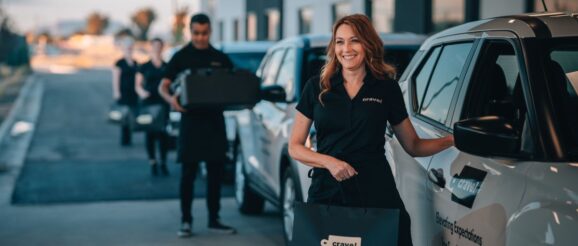Mobile Servers and Menu Innovation: Crave’s Virtual Food Hall Brings Fine Dining to the Delivery Realm

A new concept is taking shape in the world of virtual restaurants: the fine-dining virtual food hall. That idea might have been outrageous one year ago, but it’s practically necessity now, thanks to the pandemic-induced meltdown of the restaurant industry. In response, third-party hospitality and restaurant tech companies are emerging to assist these high-end concepts with the makeover they need to exist — and, more importantly, thrive — in an off-premises-centric world.
One such concept comes from Crave Hospitality Group, which will officially launch its first ghost kitchen-meets-virtual restaurant initiative in Boise, Idaho next month.
On a call last week, Crave cofounder Devin Wade talked me through the details of the operation, which he says is “hard to categorize” but probably closest to a “virtual food hall” in name. The Boise facility will house 16 restaurant concepts, including ones from James Beard nominee Lincoln Carson, Food Network Pizza Champions Challenge gold medalist Tony Gemignani, and award-winning restauranteur Michael Mina.
Chefs and their culinary teams cook and prepare the food, assisted by a tech stack that manages order fulfillment and deliveries. On the consumer-facing side, guests ordering through the Crave app can mix and match their menu choices, bundling different meals from different concepts into the same order. Food is delivered via Crave’s own fleet of drivers, and there is also a pickup option.
The official launch of the Boise location comes as full-service restaurants, including fine and higher-end ones, faces more permanent closures and, in some cities, new restrictions. The most recent numbers from the Independent Restaurant Coalition note that revenues for these businesses still “remain 60 percent lower on average than last year’s levels, with many remaining closed at a 100 percent reduction in revenue.”
The high-end restaurant experience faces an additional challenge: it is designed for a dining room, not a to-go box.
That’s a problem Wade said he had been thinking about long before COVID-19. As delivery and ghost kitchens grew in popularity over the last few years, he kept returning to the issue that delivery as-is would not work for high-end dining, and that there had to be a model where the relationships between chefs, their restaurants, kitchen providers, and delivery services was based on collaboration rather than the obsession with speed and efficiency.
Menu design was one major consideration. Award-winning chefs are “known for certain dishes,” according to Wade, which had to be accounted for on the menu. At the same time, Wade pointed out the inherently creative nature of chefs, and that this asset led the company to work with its chosen restaurant concepts on new menu items “designed to travel.”
Crave also built its own proprietary tech stack to power the Boise facility that includes everything from order processing for back-of-house management, like designating fire times for each individual food item in process. Wade says the goal of Crave’s technology is “Using tech not to dominate and push [chefs] away but to extend their food outside their restaurants.”
Part of that extension, of course, is getting the food through the actual last mile of delivery. Here, too, Crave is aiming to replicate the fine-dining experience in a to-go setting. Instead of using DoorDash or Uber Eats drivers, Crave employs its own couriers, which it calls “mobile servers.” They are W-2 employees, and many are former servers out of work because of the pandemic. They work regular hours, earn server-level wages, and follow many of the same processes they would inside a brick-and-mortar restaurant. For instance, servers meet before each dinner service so chefs can go through the night’s features. “They should know customers names, suggest a follow-up item [to customers],” says Wade, adding that the whole point is to mimic the customer-server relationship that takes place in a restaurant.
The concept is practically unheard of in the world of delivery, where nowadays many customers hit the “contactless” option in their delivery app and expect food to be dropped on the doorstep. The idea of getting to know your delivery driver seems counterintuitive to social distancing, but the decision to go this route also seems like something of a long-term play for Crave and its restaurant partners. Fear of human-to-human interaction won’t permeate the restaurant experience forever. Delivery, on the other hand, is here to stay. Over time, Crave’s efforts to mimic the server-customer relationship for delivery orders could be a bridge between those two factors.
We will have a better idea of the concept’s short-term success over the next few months. The Boise operation, which Crave has been piloting since June, just moved into its permanent space and will have its grand opening on November 17. From there, Crave plans to scale quickly: Wade says the company already has the next 15 locations mapped out, with four deals already well underway, two in the Dallas, Texas area and two in Salt Lake City, Utah.
Right now, Crave doesn’t have any real competitors in terms of operating a virtual food hall like a fine-dining restaurant. Lunchbox recently teamed up with C3 for a high-end food hall, but the higher-end part of that concept exists mostly in the food itself.
That makes Crave a rather unique player in an increasingly crowded world of ghost kitchens and virtual food halls. If its approach to delivery proves profitable for those involved, full-service restaurants may discover they have one more option when it comes to keeping the lights on during the ongoing fallout.
Get The Spoon in Your Inbox
